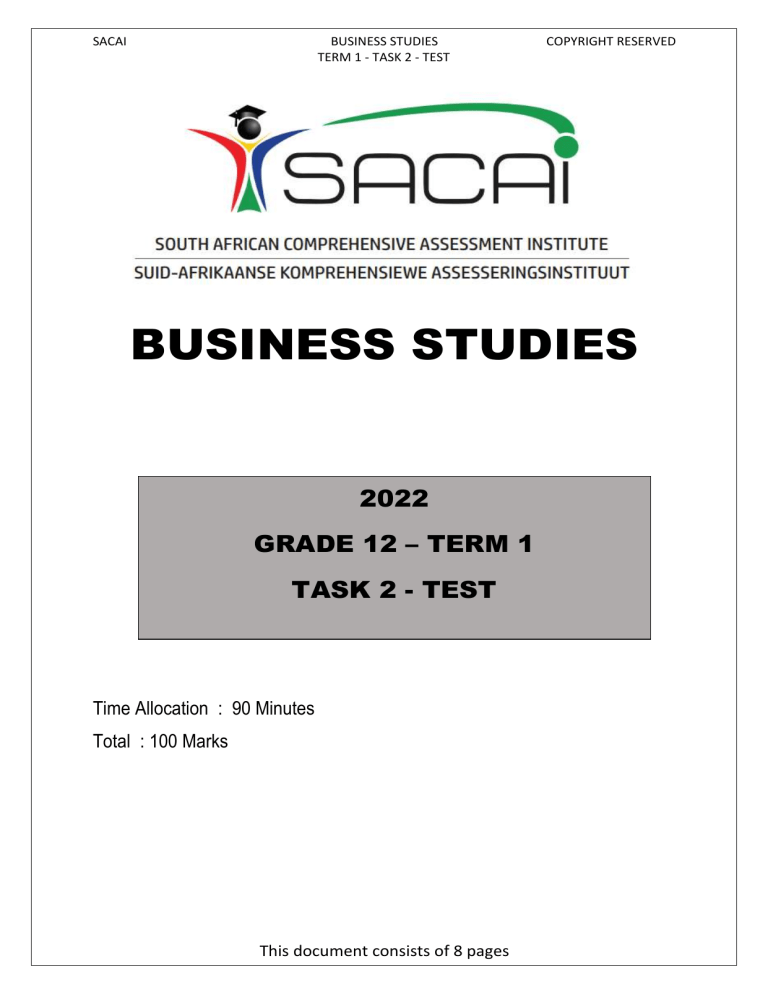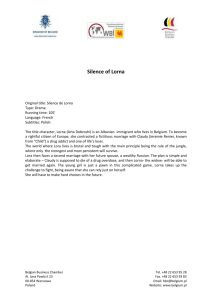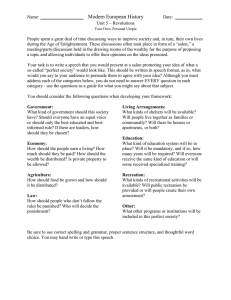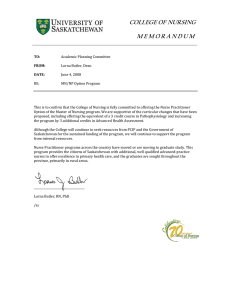
SACAI BUSINESS STUDIES TERM 1 - TASK 2 - TEST COPYRIGHT RESERVED BUSINESS STUDIES 2022 GRADE 12 – TERM 1 GRAAD 12 TASK 2 - TEST Time Allocation : 90 Minutes Total : 100 Marks This document consists of 8 pages SACAI BUSINESS STUDIES TERM 1 - TASK 2 - TEST COPYRIGHT RESERVED LEARNER INSTRUCTIONS: Read the following instructions carefully before answering the questions. 1. This question paper consists of THREE sections and covers all main topics. SECTION A: COMPULSORY. Answer ALL the questions in this section. SECTION B: Consists of TWO questions. Answer ONE question in this section. SECTION C: Consists of TWO questions. Answer ONE question in this section. 2. Read the instructions for each question carefully and take note of what is required. 3. Number the answers carefully according to the numbering system used in this question paper. No marks will be awarded for answers that are numbered incorrectly. 4. Except where other instructions are given, answers must be written in FULL sentences. 5. Use the mark allocation below as a guide when answering each question. 6. Write neatly and legibly. 7. Good luck! P a g e | 2 of 8 SACAI BUSINESS STUDIES TERM 1 - TASK 2 – TEST COPYRIGHT RESERVED SECTION A Answer ALL the questions in this section. QUESTION 1: 1.1 Various options are provided as possible answers to the following questions. Choose the answer and write only the letter (A–D) next to the question number for example: 1.1.6 D etc. 1.1.1 This Act requires a business to conduct affordability assessment to ensure that the customer has the ability to meet his or her obligation: A. B. C. D. Employment Equity Act. Compensation for Occupational and Diseases Act. Consumer Protection Act. National Credit Act. 1.1.2 This kind of remuneration is only received after a task is completed by the worker: A. B. C. D. Piecemeal. Salary. Time-related payment. Bonus. 1.1.3 The using of illegal methods to pay less tax, is known as: A. B. C. D. Unauthorised use of funds. Tax evasion. Tax avoidance. Tax reconciliation. 1.1.4 A problem-solving technique where a team of experts are given questionnaires to obtain their opinions without bringing them together: A. B. C. D. Force field analysis. Brainstorming. Delphi technique. Nominal group technique. 1.1.5 The business adds new products or services that are unrelated/ different to existing products, but which may appeal to existing/current customers: A. B. C. D. Horizontal diversification. Conglomerate diversification. Market penetration. Forward integration. Page 3 of 8 (5x2=10) SACAI BUSINESS STUDIES TERM 1 - TASK 2 – TEST COPYRIGHT RESERVED 1.2. Complete the following statements by using the word(s) provided in the list below. Write only the word(s) next to the question number (1.2.1 – 1.2.5) in the ANSWER BOOK. Fringe, Double, Divestiture, Retirement, One and a half, Ethical, Retrenchment, Liquidation, Professional, Compulsory. 1.2.1. ………………………. is when an employee reaches a certain age (normally 65) and does not have to work anymore. 1.2.2. Additional contributions made by the employer to a medical scheme for an employer is known as ……………. benefits. 1.2.3. …………… behaviour includes guidelines on employees’ appearance, communication, attitude, responsibility, etc. 1.2.4. Lorna’s Enterprises used ….............. as part of a defensive strategy when they stopped operating and sold all their assets to pay off debts. 1.2.5. Lorna received ……………… of her normal rate of pay for working on a public holiday. (5x2=10) QUESTION 1: [20] TOTAL SECTION A: [20] Page 4 of 8 SACAI BUSINESS STUDIES TERM 1 - TASK 2 – TEST COPYRIGHT RESERVED SECTION B Answer ONE of the questions in this section. QUESTION 2: 2.1. Read the scenario below and answer the questions that follow. Phumba Manufacturing Elana and Sam are employees in the same department at Phumba Manufacturing. They do the same work, but Sam earns more than Elana. She is unhappy and demands to earn the same salary as Sam. She feels that Phumba’s Manufacturing is not complying with the Employment Equity Act (EEA), 1998 (Act 55 of 1998). 2.1.1. Explain the main purpose of the Employment Equity Act (EEA), 1998 (Act 55 of 1998) with specific reference to Elana's claim of Phumba’s Manufacturing non-compliance with this Act. (4) 2.1.2. Evaluate the impact of the EEA on businesses in general. (6) 2.2. Explain the provisions of the Basic Conditions of Employment Act (BCEA), 1997 (Act 75 of 1997) in terms of: 2.2.1. Sick leave. 2.2.2. Annual leave. 2.2.3. Maternity leave. (6) 2.3. Answer the following questions on SETA’s: 2.3.1. What does the acronym SETA stand for? (1) 2.3.2. Explain how SETA’s are funded. (4) Page 5 of 8 SACAI BUSINESS STUDIES TERM 1 - TASK 2 – TEST COPYRIGHT RESERVED 2.4. Read the scenario below and answer the questions that follow. LORNA’S Salon LORNA’s Salon advertised a vacancy on the business’s social media page. Many applicants submitted their application forms online. LORNA’s Salon conducted preliminary interviews to select suitable candidates and then compiled a shortlist of five candidates. 2.4.1. Identify the type of recruitment used by LORNA’s Salon. Motivate your answer by quoting from the scenario above. (3) 2.5. Read the scenario below and answer the questions that follow. Lorna, who operates a hair salon, wants to employ two new workers. She is not sure how to draw up legal employment contracts for these workers. 2.5.1. Define the term employment contract. (2) 2.5.2. Suggest any TWO possible reasons for terminating an employment contract. (4) 2.5.3. Discuss the TWO components of the of the job analysis. (4) 2.5.4. Discuss the purpose of an interview as an activity of the human resources function. (6) TOTAL QUESTION 2: [40] QUESTION 3: 3.1. State the problem-solving technique represented in EACH of the following statements: (6) 3.1.1. Ben gives his employees the opportunity to suggest ideas randomly which are then written on a flip chart. 3.1.2. The management of Lorna’s Salon have listed the advantages and disadvantages of changing their business structure. 3.1.3. The employees of Lorna’s Salon have been requested to generate quietly as many ideas as possible and then to share them with other employees. Page 6 of 8 SACAI BUSINESS STUDIES TERM 1 - TASK 2 – TEST COPYRIGHT RESERVED 3.2. Read the scenario below and answer the questions that follow. Fancy Fashion Fancy Fashion specialises in selling women's evening dresses. The business's sales are declining and they are losing customers to businesses that sell similar products. Fancy Fashion’s management wants to design a creative marketing campaign that will increase the sales and attract new customers. 3.2.1. Name the problem-solving steps to address Fancy Fashion’s challenges. (6) 3.2.2. Discuss the advantages of creative thinking in solving Fancy Fashion’s problems. (6) 3.2.3. Recommend ways in which businesses may create an environment that promotes creative thinking in the workplace. (6) 3.3. Read the scenario below and answer the questions that follow: Computer Whizz Computer Whizz provides computer services to small businesses. The manager often needs to tell the staff to stop accessing social media and replying to personal emails during working time. 3.3.1. Quote ONE unethical business practice from the scenario above. (2) 3.3.2. Recommend ways in which Computer Whizz can address the type of unethical business practice identified in QUESTION 3.3.1. (6) 3.4. Explain how businesses should apply the following King Code principles: 3.4.1. Accountability. (4) 3.4.2. Transparency. (4) TOTAL QUESTION 3: [40] TOTAL SECTION B: [40] Page 7 of 8 SACAI BUSINESS STUDIES TERM 1 - TASK 2 – TEST COPYRIGHT RESERVED SECTION C Answer ONE question from this section. Clearly indicate the question number of each question that you choose. QUESTION 4: BUSINESS ENVIRONMENTS: (LEGISLATION) The Labour Relations Act (LRA), 1995 (Act 66 of 1995) regulates the relationship between employers and employees. Businesses that do not comply with this Act may face stiff penalties. With reference to the above write an essay on the following aspects of The Labour Relations Act: • Outline the purpose of the Labour Relations Act (LRA). • Describe any FOUR actions that can be regarded as discriminatory according to the LRA. • Evaluate the impact of the LRA on businesses. • Suggests practical ways in which businesses can comply with the LRA. [40] QUESTION 5: BUSINESS OPERATIONS (HUMAN RECOURCES) The recruitment and selection procedures must comply with the Employment Equity Act, 1998 (Act 55 of 1998). The human resource activity must comply with this Act when making new appointments. They should also know the legal requirements of the employment contract. With reference to the above write an essay on the following aspects of Human Resource Management: • Discuss the selection procedure as one of the human resource activity. • Advise businesses on the benefits of inducting new employees. • Evaluate the impact of internal recruitment on businesses. • Advise businesses on the legal requirements of the employment contract. [40] TOTAL SECTION C: [40] GRAND TOTAL: [100] Page 8 of 8





